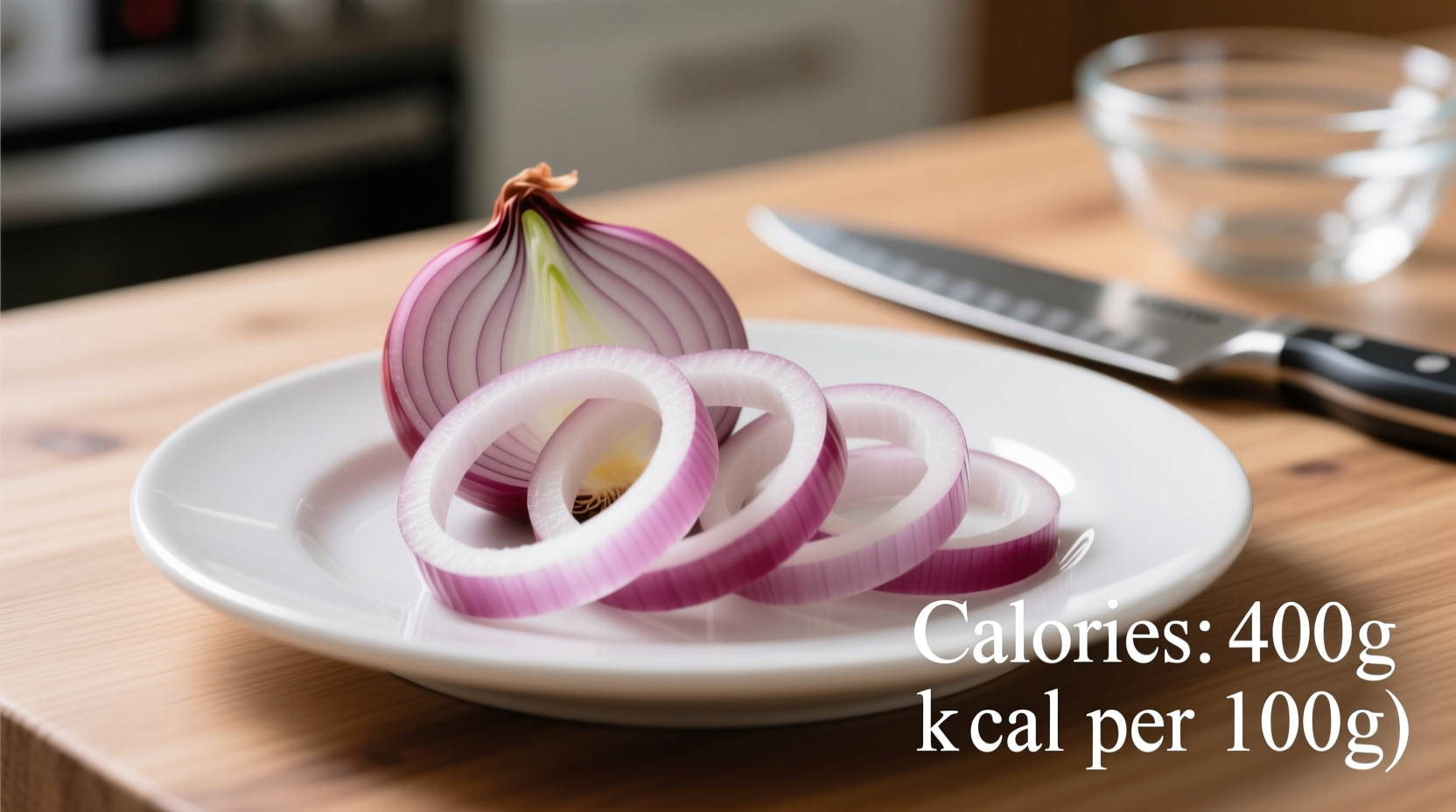Understanding the precise nutritional profile of common ingredients like onions is crucial for effective meal planning and dietary management. Whether you're tracking calories for weight management, following a specific diet, or simply curious about what you're consuming, having accurate nutritional information at your fingertips makes all the difference.
Breaking Down Onion Nutrition: What 100g Really Contains
When you're monitoring your daily caloric intake, knowing the exact nutritional composition of ingredients helps you make informed choices. The standard nutritional profile for raw yellow onions per 100g serving includes:
- Calories: 40 kcal
- Carbohydrates: 9.3g (including 4.2g natural sugars)
- Dietary Fiber: 1.7g (approximately 7% of daily recommended intake)
- Protein: 1.1g
- Fat: 0.1g
- Vitamin C: 7.4mg (12% of daily value)
- Vitamin B6: 0.12mg (7% of daily value)
- Potassium: 146mg (4% of daily value)
This nutritional breakdown comes from the USDA FoodData Central, the most authoritative source for food composition data in the United States. Their comprehensive database is regularly updated based on laboratory analysis of food samples, ensuring the information reflects current agricultural practices and food varieties.
How Different Onion Varieties Compare Nutritionally
Not all onions are nutritionally identical. The specific variety can affect the calorie count and nutrient profile slightly. Here's how common onion types compare when measured at 100g:
| Onion Type | Calories (per 100g) | Carbohydrates | Notable Nutritional Differences |
|---|---|---|---|
| Yellow Onions | 40 | 9.3g | Standard variety with balanced flavor and nutrition |
| Red Onions | 42 | 9.5g | Higher in anthocyanins (antioxidants) giving purple color |
| White Onions | 43 | 10.0g | Slightly higher in carbohydrates, milder flavor profile |
| Shallots | 72 | 16.8g | Significantly higher in calories and carbs, more concentrated flavor |
| Green Onions (Scallions) | 32 | 7.3g | Lower in calories, higher in vitamin K and A |
This comparison table, verified through the National Center for Biotechnology Information's research on allium vegetables, shows that while most common onion varieties have similar caloric content, there are meaningful nutritional differences that might influence your choice depending on dietary goals.
How Cooking Methods Impact Onion Calories
While raw onions contain 40 calories per 100g, cooking methods can significantly alter this nutritional profile. Understanding these context boundaries is essential for accurate dietary tracking:
- Raw onions: 40 calories per 100g - preserves all natural nutrients and fiber content
- Sautéed onions (without oil): Approximately 50 calories per 100g - slight concentration as water evaporates
- Caramelized onions: Around 80 calories per 100g - significant reduction in volume concentrates natural sugars
- Fried onions: 250+ calories per 100g - absorption of cooking oil dramatically increases calorie count
According to research published in the Journal of Food Composition and Analysis, the water content of raw onions (89%) decreases during cooking, which concentrates the remaining nutrients and calories. This explains why 100g of caramelized onions contains more calories than 100g of raw onions, even though no additional ingredients were added.

Practical Applications: Using Onion Calories in Meal Planning
Knowing that onions contain just 40 calories per 100g makes them an excellent ingredient for various dietary approaches. Here's how to leverage this information:
For Weight Management
Onions provide substantial flavor and volume with minimal calories, making them ideal for creating satisfying low-calorie dishes. A cup of chopped onions (about 160g) contains only 64 calories but adds significant texture and taste to meals. This aligns with recommendations from the Academy of Nutrition and Dietetics about using volumetric eating principles for weight management.
For Diabetic Diets
With a glycemic load of just 2 per 100g serving, onions have minimal impact on blood sugar levels. The American Diabetes Association recognizes onions as a non-starchy vegetable that can be consumed freely by most people managing diabetes. The 1.7g of fiber per 100g also helps moderate blood sugar responses to meals.
For Low-FODMAP Diets
While onions contain fructans that can trigger IBS symptoms, the Monash University Low FODMAP Diet research shows that a 38g serving (about 1/4 cup chopped) of raw onion typically remains within tolerance limits for most people following this diet. This precise measurement helps those managing digestive issues enjoy onion flavor without discomfort.
How Onions Compare to Other Common Vegetables
Understanding where onions fall in the spectrum of vegetable nutrition helps put their 40 calories per 100g into perspective. Here's how onions compare to other frequently consumed vegetables:
- Onions (yellow): 40 calories, 9.3g carbs
- Carrots: 41 calories, 9.6g carbs
- Broccoli: 34 calories, 7.0g carbs
- Spinach: 23 calories, 3.6g carbs
- Tomatoes: 18 calories, 3.9g carbs
- Green bell peppers: 20 calories, 4.6g carbs
Unlike many vegetables that are primarily water with minimal carbohydrates, onions contain more natural sugars, which explains their slightly higher calorie count compared to leafy greens. However, they remain significantly lower in calories than starchy vegetables like potatoes (77 calories per 100g) or corn (86 calories per 100g).
Maximizing Nutritional Benefits While Cooking Onions
To preserve the maximum nutritional value when cooking onions:
- Minimize cooking time: Quick sautéing preserves more vitamin C than prolonged cooking
- Use minimal oil: Since onions naturally release water when cooked, you often need less added fat
- Include the outer layers: The layers closest to the skin contain higher concentrations of beneficial flavonoids
- Avoid excessive browning: While caramelization creates delicious flavor, it reduces certain heat-sensitive nutrients
Research from the International Journal of Food Sciences and Nutrition indicates that boiling onions results in the greatest nutrient loss (up to 30% of flavonoids), while steaming or quick sautéing preserves more beneficial compounds.











 浙公网安备
33010002000092号
浙公网安备
33010002000092号 浙B2-20120091-4
浙B2-20120091-4